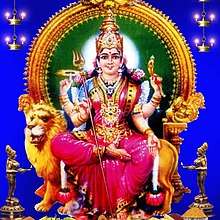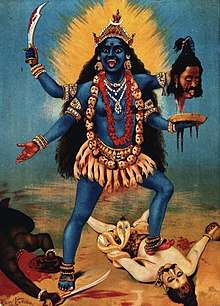Sri Ramalinga Sowdeswari Amman
Sri Ramalinga Sowdeswari Amman is a Hindu deity, also known as Sri Chowdeshwari Devi (Hindi : श्री रामलिंग चौडेस्वरी माता, Tamil : ஸ்ரீ ராமலிங்கசௌடேஸ்வரிஅம்மன், Malayalam :ശ്രീ രാമലിംഗ ചൌഡേശ്വരി അമ്മൻ, Kannada : ಶ್ರೀ ರಾಮಲಿಂಗ ಚೌಡೆಸ್ವಾರಿ ದೇವಿ, Telugu: శ్రీ రామలింగ చౌదెస్వరి దేవి). This goddess is worshiped as Sri Chowdeshwari Devi or Sri Ramalinga Sowdeswari Amman in three forms: Shakti, Chamunda, and Jyothi (the divine light). Her other names are Banashankari and Soodambigai. She is Kuladevatha of Devanga people.[1]
| Sri Ramalinga Sowdeswari Amman | |
|---|---|
Kuladevatha of the Devanga People | |
 Sri Ramalinga Sowdeswari Amman Sri Sowdeswari Devi | |
| Affiliation | Devi |
| Mantra | Oṃ Eesa Pathni sa Vithmahey Simha Twajaya dhimahi Thannoh Sowdi prachodayāt (for Ramalinga Sowdeswari Amman) Om Sri Sri Sri Viraat Rupaya Mahamardini Tanno Chowdeshwari Prachodayat (for Chowdeshwari devi) |
| Weapon | Trishula |
| Mount | Lion (Dawon) |
| Consort | Shiva in the form of Ramalingeswara |
| Sri Ramalinga sowdeswari amman temple | |
|---|---|
| Religion | |
| Affiliation | Hinduism |
| District | All districts in Karnataka, Tamil Nadu (mostly in Salem), Kerala (mostly in Kuthampully), Andhra Pradesh (especially in Nandavaram), Delhi, Maharashtra, and in some districts of other states. |
| Location | |
| Location | Temples are located all over India |
| State | Karnataka, Telangana, Andhra Pradesh, Tamil Nadu, Kerala, Odisha, Madhya Pradesh, Delhi. |
| Country | India |
 Location in Tamil Nadu  Location in India | |
| Geographic coordinates | 11°38′40.9″N 78°09′10.1″E |
History
According to the Devanga Purana, Sage Devala,is the progenitor of the Devanga community.[2] He emerged from the third eye of Lord Shiva (or, in some accounts, from Shiva's heart) to create clothing and to teach weaving to the world. When Devala returned after obtaining threads from Lord Vishnu's lotus navel, a group of five demons, Vajramushti, Dhoomravakra, Dhoomratchasa, Chithrasena and Panchasena, attacked him at midnight. In the dark, the power of the demons was overwhelming. Devala attempted to fight them off using Vishnu's Sudarshana Chakra, but failed, and finally prayed for Shakti to protect him. Shakti appeared in light and glory, wearing a bright full crown, holding a trident and other weapons in her hand while mounted on a lion. She killed the demons; their blood was white, black, red, green, and yellow. Devala soaked his threads in the demon's colorful blood. Shakti was then given the name Chowdeshwari or Sowdeswari (Chowda/Sowda/Sooda=the brightness). Sowdeswari advised Devala to worship her during every new moon (Amavasya).[3]
Devala went to the south Himalayas and founded Sagara Kingdom with Amodh Nagar as its capital. He wove new clothes and gave them to all: the gods (Trimurti and Tridevi), demigods (Deva, Asura), immortals (Gandarva, Kinnara) and humans. Devala gave clothes to cover Deva's body parts so his community is named as Devanga (Anga=Body part) Community. He married Suryadev's Sister DevaDhutta so as surya is first kinsmen , Then Aadhi shesha's daughter ChandraReka so Devanga people are called as Sedar/Jendar (Aadhi shesha is written as Aadhi Seda in tamil) and then he married Asura Vakrathantha's daughter AgniDhutta.People who follow Devala are known as Devanga or Devangar.[4]
In Tamil Nadu
The ancient Devanga community who worshipped the goddess in Tamil Nadu dispersed to other states, including Karnataka, Andhra Pradesh and Kerala. They brought the weaving industry to their new home towns and set up temples of Sri Ramalinga Sowdeswari Amman as their deity. The Kannada-speaking Devanga community in Tamil Nadu is also known as Devanga Chettiar. They reside in a number of locations in the Coimbatore, Theni, Dindigul, Salem, Erode, Madurai and Virudhunagar districts. Although their religious practices fall into the Saivism and Vaishnavism denominations of Hinduism. they generally worship Sri Ramalinga Sowdeswari Amman. There are 10,000 Vamsa/Vansh clans in the Devanga community.
Chowdeshwari vs Ramalinga Sowdeswari
Devanga people originally followed Shaktism and worshipped the goddess in the form of Chowdeshwari.King Devadas built a temple and invited Lord Shiva as Ramalingeshwara and Parvathi as Sowdeswari from Srisailam temple, after that they adopted some Hindu traditions, worshipping Chowdeshwari along with RamaBana ( Lord Ram's Bow) and Lingam (Shiva), as Sri Ramalinga Sowdeswari Amman. In general the Devanga people worship Sri Ramalinga Sowdeswari Amman as well as Chowdeshwari Devi, and several other names. [5] while the Nepali Korakpur Devanga people worship her as Komalangi Devi.
Festivals
- Devanga new year: Those who follow the calendar of moon's rotation celebrate their new year on the day of Ugadi. If they follow the sun's rotation calendar, they celebrate their new year on the day of Chaithra 1. Most communities celebrate Ugadi as their new year.
- Chaitra Suddha Panchami: This is the birthday celebration of Sage Devala. It is celebrated on the fifth Thithi day after Ugadi.
- Ashadha Amavasya: This is the birthday celebration of the Goddess, commemorating Sowdeswari's rescue of Sage Devala and her conquest over the demons. It is celebrated on Amavasya of Ashadha month. The Devanga people also celebrate every Amavasya as their holy day, stopping weaving and offering prayers to Chowdeshwari.[3]
- Devanga Janivara: Devanga people follow Rig Upakarma and therefore celebrate Janivara on the Shraavana Purnima (full moon day) of the traditional Hindu calendar, which is also the day of Raksha Bandhan in North India. It is known as Avani Avittam in Tamil Nadu and Kerala.
- Yearly Festival (Varusha Habba): The yearly festival of Sowdeswari Amman Temple usually falls during the season of Navratri but varies depending on the tradition of the area. It includes Alagu Sevai, Shakti Chamunda Jyothi pooja, Manja Neer Meravana, and Amman Beethi Ulaa. It is also known as Aikilu Habba.
- Sankranti: Most Devanga people celebrate the Sankranti festival. In Tamil Nadu, they celebrate Pongal instead of Sankranthi.
- Diwali: Not all Devanga groups celebrate Diwali. This varies by family tradition.
- Janmastami: The Devanga people celebrate the Krishna Ashtami festival.
- Ramnavami: As the Devanga pray to Lord Shiva in the form of Ramalingeshwar, they also celebrate Ramnavami.
The Devanga community flag is yellow, with the figures of Nandhi, Surya and Chandra depicted in green.
Pooja rituals in Sowdeswari Temple
The pooja rituals for Sri Ramalinga Sowdeswari Amman are a mixture of the culture of North and South India. The celebrants build a small cart-like building using jaggery, roof it with sugarcane and use Betel leaf for decoration. A special turmeric called pandaram is offered as Prasāda for the deities. The Devanga people perform all their rituals by themselves.[6]
Alagu seva
This ritual derives from the story that King Devadas, the seventh incarnation of Devala, built a beautiful temple for Sowdeshwari. He invited Lord Shiva and Parvathi from Srisailam to the temple but on the way Parvathi disappeared in the water as Devadas broke his promise. Devadas and his soldiers then wounded themselves with swords and suddenly the goddess appeared and joined them.[7] The alagu seva ritual commemorates this event and invokes Sowdeswari Amman. It is performed only by the Devanga people.[8] The holy turmeric mixture, pandaram, is applied to the wounds to protect them from infection. The celebrants, called veerakumars, strike their bare chests with holy swords in a ritual dance. The ritual is also called alagu seva or katthi haakkadhu.[9]

Jagajathara Dhoddabba
Jagajathara Dhoddabba is a five-day festival celebrated for Sri Ramalinga Sowdeswari Amman.[10]
Sakthi: It is dedicated to the goddess Sakthi – "Irumaneru" clan goddess will be revered for Sakthi function.
Chamundi: It is dedicated to the goddess Chamundeswari – "Yendhelaaru" clan goddess will be revered for Chamundi fucntion.
Jyothi: It is dedicated to goddess Jyothi Light – "Ladhiyagaaru" clan goddess will be revered for Maha Jyothi.
Gundam: The fourth day of the festival dedicated to the goddess Gundam – "Kappelaaaru" clan goddess will be revered for Gundam.[11]
The famous chant slogan "Shakthi Chamundi Jyothi amma Baa maa" is used while invoking the goddesses.
Monasteries and temples
Hemakooda monastery
The Gayathri Peedam Hemakooda (Hemakooda monastery) in Hampi, Karnataka is led by Devanga Kula Jegath Guru Abbot Hampi Hemakooda Gayathri Peeda Sri Sri Sri Dhayananthapuri swamiji, a leader of the Devanga community.[12][13][14]

Sambusailam monastery
The Sambusailam monastery at Jalakandapuram, Tamil Nadu is led by Devangakula Guru Abbot Chandramouleswara Swamiji.[15]

Temples
The main temple to the goddess Sri Ramalinga Sowdeswari Amman is located in Hampi, Karnataka. It is known as Thai Sthalam (Mother Temple). The temple located in Dharapuram is also known as Thai Sthalam. There are many Sri Ramalinga Sowdeswari Amman temples in Tamil Nadu. In other states, the goddess is known as Sri Banashankari, Sri Chowdeswari, Sowdamman, or Soodambigai.
Bibliography
- Pintchman, Tracy (1994). The Rise of the Goddess in the Hindu Tradition. SUNY Press, New York. ISBN 0-7914-2112-0.
- Census of India, 1961: Madras[16]
- Salem City, 1980[17]
- South India[18]
- 2nd Congress on Traditional Sciences and Technologies of India, 27–31 December 1995, Anna University, Madras[19]
- People of India[20]
- Wangu, Madhu Bazaz (2003).[21]
- Religions in the Modern World[22]
References
- "MGR magic still spins votes from Coimbatore weavers". The Times of India. Retrieved 25 November 2018.
- "Devanga Purana - தேவாங்க புராணம் - Devalar - Devala Maharishi". Devangakula.org. Retrieved 14 June 2019.
- "speciality of Aashada New Moon Day - ஆடி அமாவாசை சிறப்பு". Devangakula.org. Retrieved 14 June 2019.
- "Devala munivar and avatars - தேவல முனிவரும் அவதாரங்களும்". Devangakula.org. Retrieved 14 June 2019.
- "Erikarai Sri Ramalinga Sowdeswari Amman Jalakandapuram". Sites.google.com.
- "அலகு சேவை". Devangakula.org. Retrieved 14 June 2019.
- "Ramalinga Sowdeswari Amman festival". Peliharaburung.com.
- "About Devanga Guru". Devanga.org.
- "Deavnga Guru and monastery". Devangaworld.com.
- "Inaguration of Devanga bruhat Samavesha". Yeddyurappa.in.
- "Devanga monastery details". Devanga.org.
- General, India Office of the Registrar (15 June 1968). "Census of India, 1961: Madras". Manager of Publications. Retrieved 15 June 2019 – via Google Books.
- Nārāyaṇaṉ, Ka Ilakkumi; Gangadharan, T.; Chandrasekar, N. (15 June 1999). "Salem City: An Ethnohistory (1792-1992)". Vysya college. Retrieved 15 June 2019 – via Google Books.
- Abram, David; Guides (Firm), Rough; Edwards, Nick (15 June 2019). "The Rough Guide to South India". Rough Guides. Retrieved 15 June 2019 – via Google Books.
- University, Anna; Foundation, P. P. S. T. (15 June 1995). "2nd Congress on Traditional Sciences and Technologies of India, 27th-31st December 1995, Anna University, Madras". PPST Foundation. Retrieved 15 June 2019 – via Google Books.
- Singh, Kumar Suresh; Thirumalai, R.; Manoharan, S. (30 January 1997). "People Of India: Tamil Nadu". Affiliated East-West Press [for] Anthropological Survey of India. Retrieved 15 June 2019 – via Google Books.
- Images of Indian Goddesses: Myths, Meanings, and Models. New Delhi, India: Abhinav Publications. ISBN 81-7017-416-3.
- Linda Woodhead, ed. (26 May 2009). Religions in the Modern World (2nd ed.). Routledge. ISBN 978-0415458917.
